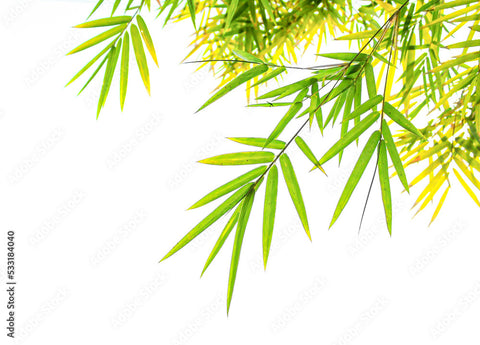Bamboo is a popular plant for both refreshing indoor interiors and making gardens more lively. The plant stays green all year round, provided it receives proper care. The thousand-year-old super grass is even said to have miraculous powers that remove negative energy from the environment. According to Chinese Feng Shui philosophy, having a bamboo plant brings wealth, health, and happiness. Additionally, bamboo has a cooling effect and acts as natural air conditioning for the immediate environment. Global warming means increasingly hotter summers, but this plant can lower the temperature by up to eight degrees in both gardens and enclosed rooms. Good reasons to get your own bamboo, but how do you maintain it? Bamboo plant care is fortunately not as difficult as it seems.
How do I plant my bamboo?
Bamboo comes in various types and sizes. There are about 1000 bamboo species! The new environment of the bamboo plant determines its care since there's a big difference between indoor and outdoor care. Additionally, attention must be paid to the bamboo variety, because before you know it, an entire bamboo forest could grow in your garden. The way the bamboo is planted influences a large part of the super grass's life.
Outdoor Bamboo
It's best to plant bamboo in the period between February and early autumn in a garden spot that isn't too wet. If the soil is too wet, there's a high risk of root rot. When planting bamboo, it's important to dig a hole at least twice the size of the root ball. The super grass loves space. The root ball should be dipped in water before placement and can then be placed directly in the ground. The hole is then filled with organic material such as wood chips or fallen leaves. Afterward, the new bamboo plant should receive plenty of water to eliminate all air pockets around the root ball. In the first week, the grass is extra thirsty, so it's important to water it daily. After that, watering every 2 to 3 days is sufficient, depending on the plant's location and how many hours of sunlight the bamboo receives. Outdoor bamboo plant care often happens largely by itself because nature helps a great deal.
If the bamboo isn't placed directly in garden soil but in a planter, hydro granules should first be scattered at the bottom of the pot. This distributes water more evenly, and excess water can be reabsorbed. This reduces the chance of bamboo roots rotting. Furthermore, the planter can be filled with normal potting soil, and sufficient watering in the initial period is crucial. It's best to choose medium-height or low-growing bamboo in pots, as these don't grow as quickly as their counterparts.

Running vs. Non-running bamboo
Before acquiring a new bamboo plant for the garden, one must be aware of the different types of bamboo available. The grass is notorious for its aggressive growth that can provoke many neighborly disputes, but this doesn't apply to all varieties. The growth pattern determines the difference between running and non-running bamboo. Non-running bamboo forms new shoots via a single clump and thus concentrates on uniform growth. Running bamboos, on the other hand, are known for their rapid growth and expanding ability in the garden through underground runners. The roots often multiply uncontrollably and can suppress other plants. This is because this bamboo forms underground root runners (rhizomes) that dig horizontally through the soil where new bamboo shoots grow. Suddenly, a new sprout might appear two meters away from the original bamboo plant. With a small garden, running bamboo is therefore not a good idea. However, you can contain the roots of this type with a root barrier. This is buried at least 65 centimeters deep in the ground around the root ball of the super grass, forming a fence for the territory where only the bamboo may grow. This way, you prevent a bamboo invasion in the garden. Always research with the seller which bamboo species it is. Would you rather place the bamboo outside in a pot? Then it's best to choose a non-running bamboo species, such as Fargesia. There's a small chance the pot will crack due to the strong roots.
Indoor Bamboo
Bamboo also shines in indoor spaces and is an easy plant to maintain. This bamboo species is often kept in a small cluster of stems with small roots at the ends, also known as lucky bamboo. Having a mature bamboo shrub with root ball is more difficult indoors due to low humidity and lack of light and space. Lucky bamboo is therefore a good compromise. It's a true water lover and thrives in lots of water, unlike outdoor bamboo. The loose stems look beautiful in, for example, a transparent vase where you can see the growth process. A layer of at least 5 centimeters of pebbles or gravel is placed at the bottom of the vase so the plant can stand upright properly, depending on the size of the stems. Then the pot is filled with water to just above the stone layer. Bamboo is said to increase oxygen levels in rooms and can even filter air. Would you prefer a bamboo shrub in a pot? Having a bamboo plant with root ball is unfortunately more difficult indoors because the humidity is often too low. In this case, always ensure this level is at least 50 percent.
Help! My bamboo is getting yellow leaves
Don't panic, there's a good chance that bamboo will get a few yellow leaves in autumn. This is a very natural process, like many other tree and grass species that begin shedding leaves at the end of summer in preparation for the winter season. The number of yellow leaves depends on the size and type of bamboo. Young bamboo has somewhat less leaf drop. However, it's important to further investigate the plant when leaves change color in other seasons such as winter, summer, or spring.
Firstly, waterlogging could be a cause for the sudden change in color. Bamboo loves water immensely, but too much watering can cause the hair roots to remain underwater for long periods, preventing them from getting oxygen. This can cause the sensitive roots to die. Therefore, it's important to dig up the bamboo with its root ball so the roots can dry. When it concerns outdoor bamboo, the soil around the roots can be loosened so the branches can get air and recover.
Another possible cause for yellow leaves is chlorosis. A difficult word, but it simply means a deficiency in nutrients such as iron, magnesium, or nitrogen. Buying appropriate bamboo fertilizer can be a solution to perk up the super grass and make it beautifully green again. Even bamboo sometimes needs super foods and enjoys a treat! You can safely leave the fallen leaves around the bamboo plant, as the leaves still contain nutrients that the soil will absorb. It serves as a self-sustaining compost. Bamboo is sustainable!
Indoor bamboo can also suffer from yellow leaves. This often occurs because the water in the pot or vase is no longer healthy for the plant. Therefore, it's important to remove the lucky bamboo from the pebble soil and change all the water. If tap water contains a lot of chlorine or fluoride, it's best to choose bottled water or filtered water as it has less salt and more minerals. The bamboo notices when the space becomes too dry, and then the leaves can also turn yellow. Higher humidity is therefore desired, especially in winter months when indoor heating is turned on again. A bowl of water on the radiator works wonders for bamboo! The water will evaporate due to the heat and automatically makes the air more humid. When the top of the bamboo stem is dying and turns dark yellow, it's best to cut off the dead piece of bamboo. This allows the rest of the plant to recover and the bamboo will grow back beautifully.

How do I maintain my bamboo?
Fortunately, bamboo is a simple plant in terms of care and is not demanding. Primarily, providing sufficient water makes the plant happy. Occasionally removing aged culms and leaves will do the bamboo good, just like a haircut. However, it's important to be well-informed about which bamboo species has been purchased. Each bamboo has its own character and accompanying manual. But in general, the basic rules mentioned here apply to every bamboo plant and its bamboo maintenance. Bamboo flowering is very irregular and varies by bamboo species. The chance that your bamboo will flower is very small. It can take up to 120 years before the grass enters a flowering period! Pruning bamboo is often not necessary. The bamboo plant naturally drops leaves that have died. Therefore, pruning is only common if the bamboo needs to look fresher.
Sunlight
Sunlight plays a major role in the life of the bamboo plant. Too much direct sunlight doesn't make the super grass happy and can cause loss of leaves. The indoor bamboo plant can sometimes be picky about which spot in the room it likes best. Placing the bamboo in different locations can help figure out where the plant feels most at home. Preferably in a bright spot near the window. Outdoor bamboo, on the other hand, is less picky with sunlight and mainly needs lots of water. Moving a mature bamboo shrub in the garden is quite difficult. If the outdoor bamboo lives in a pot and gets yellow leaves, it can help to place it in partial shade. This way, the super grass can heal from excessive sun hours.
Does bamboo need a lot of water?
The green super grass can survive fine without water for a short time and survives a drier period. Bamboo communicates through its leaves when it's thirsty by curling them up. When the plant has gone too long without water, it drops some leaves so the rest of the plant stays sufficiently hydrated, a true sacrifice indeed. However, it's important to monitor that the bamboo constantly has moist soil. Watering bamboo is especially important in summer because the bamboo plant is extra thirsty then. The soil should never completely dry out, as there's a risk the bamboo plant will die.
And which fertilizer is best?
Outdoor bamboo loves fertilization! Therefore, some extra bamboo fertilizer, especially in summer and spring months, can't hurt. Spring is the best period to give the super grass a boost because this is the growing season for the plant. Organic fertilizer such as cow manure pellets works fine for bamboo, just make sure the phosphate content is low. Nitrogen-containing fertilizers stimulate healthy growth and help the plant recover after cold winter time. All in all, the NPK rule applies to fertilizer products because these form the nutrients necessary for healthy plants. Fertilizer should contain lots of nitrogen (N), phosphorus (P), and potassium (K), so when in doubt, always read the label of the fertilizer packaging. Fertilizing 3 to 4 times per year is sufficient for the super grass. Depending on the size of the bamboo, a handful to a scoop of fertilizer is spread between the grass stalks and topped with water. For indoor lucky bamboo, fertilizer is of course not necessary, as it stands in water and gravel all year round.

Aphids! What now?
Bamboo is a strong plant that has little trouble with pests and other external ailments. However, sometimes aphids from other plants can transfer to the super grass. Especially when the plant isn't feeling well, it's more susceptible to unwanted guests. Don't worry, aphids are not harmful to the growth process and with good care and sufficient water, the aphids often disappear on their own. Often a strong water jet is enough to wash away the aphids, or place the pot with bamboo in the rain overnight. If the aphids are persistent, you can choose to deploy natural enemies (ladybugs for example) that eat the unwanted insects.




































